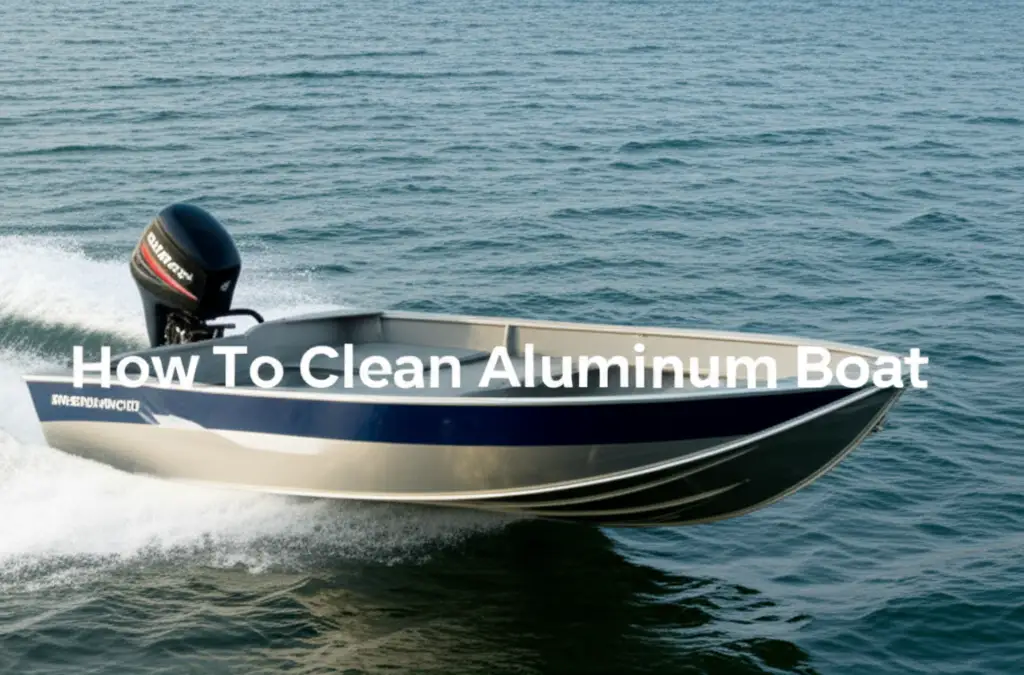· Boat Maintenance · 16 min read
How To Clean Boat Hull Fiberglass

Unlock a Spotless Shine: How to Clean Boat Hull Fiberglass
Keeping your boat looking its best is a priority for any owner. A clean boat hull not only makes your vessel shine but also protects its integrity. Over time, salt, sun, and marine life take their toll on fiberglass surfaces. This can lead to unsightly oxidation, stubborn stains, and marine growth. Understanding how to clean boat hull fiberglass is key to maintaining its value and appearance. I will guide you through a comprehensive process. This guide provides steps and tips to restore your boat’s gleaming finish.
I will cover essential tools you need for boat hull cleaning. We will explore effective methods for tackling common problems like oxidation and stubborn stains. I will also discuss how to handle mold, mildew, and marine growth. Finally, I will share tips for protecting your hull after cleaning. You will learn to keep your boat looking new for longer. Get ready to transform your boat.
Takeaway:
- Regular cleaning prevents major damage and maintains your boat’s value.
- Use specific cleaners for oxidation, stains, and marine growth for best results.
- Always protect your fiberglass hull with wax or sealant after cleaning.
- Choose suitable tools and prioritize safety during the cleaning process.
- Address mold and mildew quickly to prevent deeper issues.
To clean boat hull fiberglass, start by rinsing it thoroughly to remove loose debris. Then, wash the surface with a marine-grade boat soap. Apply specialized oxidation removers or stain removers as needed. Scrub away marine growth carefully. Finish with a complete rinse and apply a protective wax or sealant.
Why Your Boat Hull Fiberglass Needs Regular Care
Your boat’s hull is its protective shield against the harsh marine environment. Most boat hulls use fiberglass, specifically a gelcoat layer over fiberglass. This gelcoat gives your boat its color and glossy finish. It is also the first line of defense against elements like UV rays, saltwater, and pollutants. Over time, these elements cause damage. Regular cleaning is important to prevent this damage.
I know how frustrating it is to see a once-shiny hull become dull. This dullness often comes from oxidation. Oxidation is a common problem where the gelcoat breaks down due to sun exposure. It looks like a chalky, faded layer on the surface. If you do not remove oxidation, it makes the hull look old and uncared for. It also makes the gelcoat more porous, leading to more staining. Keeping your hull clean removes these harmful layers. You keep the gelcoat smooth and resilient.
Beyond oxidation, your hull faces other threats. Marine growth like algae, barnacles, and slime attach to the bottom. These growths slow your boat down, increasing fuel consumption. They can also damage the hull’s surface over time. Stains from rust, exhaust, or chemicals also appear. These stains are not just ugly. Some can be acidic and damage the gelcoat. Regular cleaning removes these issues before they become permanent. It preserves the structural integrity and appearance of your fiberglass hull. This helps protect your investment. Maintaining your fiberglass hull also makes the boat easier to sell later. For more information on maintaining fiberglass surfaces, you can explore guides on how to clean fiberglass shower floor. Understanding basic fiberglass care helps across different applications.
Gathering Your Essential Boat Hull Cleaning Arsenal
Before you start scrubbing, prepare your cleaning station. Having the right tools and supplies makes the job easier and safer. Using incorrect products can damage your fiberglass. I always start by gathering everything I need. This saves time and prevents interruptions. A well-prepared approach leads to better results.
First, you need basic cleaning tools. You will need at least two large buckets. One is for soapy water, the other for rinsing. A garden hose with a spray nozzle provides water pressure. Choose soft-bristle brushes and sponges that are safe for gelcoat. Avoid stiff brushes or abrasive pads. They can scratch the delicate surface. For tough spots, a soft-bristle deck brush with an extendable handle is helpful. This lets you reach all areas of the hull.
Next, select your cleaning solutions carefully. A marine-grade boat soap is essential for general washing. These soaps are pH-neutral and designed not to strip wax. For oxidation, you will need a specialized oxidation remover. These products contain mild acids or abrasives that safely remove the oxidized layer. For waterline stains or rust, an oxalic acid-based hull cleaner works wonders. This cleaner makes yellowing disappear. For marine growth, look for an enzyme-based cleaner or a scraping tool. Always read product labels. Ensure they are safe for fiberglass gelcoat.
Finally, do not forget safety gear. Cleaning chemicals can irritate skin and eyes. I always wear rubber gloves to protect my hands. Eye protection, like safety glasses, is also crucial. If you work in an enclosed space, consider a respirator. A non-slip surface or sturdy ladder is important if working on a boat lift or trailer. Your safety is paramount. Having all these items ready before you begin helps ensure a successful and safe cleaning process.
The Step-by-Step Process for a Sparkling Fiberglass Hull
Cleaning your boat’s hull fiberglass effectively requires a systematic approach. Rushing the process can lead to missed spots or even damage. I break it down into manageable steps. This ensures thorough cleaning and brilliant results. Follow these stages for a hull that truly shines.
Preparing Your Boat for Cleaning
Preparation is key for any cleaning project. Start by moving your boat to a suitable location. A shaded area is best. This prevents cleaning solutions from drying too quickly. Drying solutions leave streaks or hard-to-remove residue. If your boat is on a trailer, ensure it is stable. If it is in the water, check the tides. You want enough access to the hull.
Before applying any cleaners, rinse the entire hull with fresh water. Use a strong stream from your hose. This removes loose dirt, salt, and light grime. A good pre-rinse minimizes scratching. It reduces the amount of cleaner you need. I always make sure to rinse from top to bottom. This lets gravity help carry away debris.
Washing Away Surface Grime and Salt
Now it is time for the general wash. Fill one bucket with marine-grade boat soap mixed with water. Follow the product’s dilution instructions. Use your soft-bristle brush or sponge. Work in small sections, from top to bottom. This ensures you do not miss any areas. Scrub gently but firmly to lift dirt and salt.
Once you scrub a section, rinse it immediately and thoroughly with fresh water. Do not let the soapy water dry on the hull. This can leave streaks or water spots. Continue this wash-and-rinse method for the entire hull. Pay attention to the waterline and any areas with noticeable grime. This initial wash removes most surface contaminants. It prepares the hull for more intensive treatments.
Tackling Oxidation: Restoring Gelcoat Shine
Oxidation is common on older or neglected fiberglass hulls. It appears as a dull, chalky film. To remove light oxidation, a rubbing compound designed for gelcoat works well. Apply a small amount to a clean cloth or buffer pad. Work it into the surface in small circular motions. For heavier oxidation, you may need a more aggressive compound or a rotary buffer. Be careful with buffers. They can burn the gelcoat if used improperly.
After applying the compound, wipe away the residue with a clean cloth. You should see the shine start to return. If one application is not enough, repeat the process. Always follow the product’s instructions for best results. Removing oxidation brings back the original color and luster of your boat.
Eradicating Stubborn Stains and Yellowing
Stubborn stains like rust, exhaust, or waterline yellowing require specific treatments. For waterline stains and general yellowing, I use an oxalic acid-based hull cleaner. These cleaners are very effective. They bleach away the stains without harsh scrubbing. Simply apply the cleaner to the affected area. Let it sit for a few minutes, as directed by the product. You will often see the stain disappear before your eyes. Rinse thoroughly after use.
For rust stains, a rust remover specifically for boats works best. Apply it directly to the stain. Let it dwell, then rinse. For other general tough spots or grime, you might find some techniques used in other areas helpful. For example, strategies for cleaning tough grime on surfaces can be found in articles like how to clean bottom of shower. This might give you ideas for persistent, stuck-on dirt on your hull. Always test in an inconspicuous area first, especially with stronger chemicals.
Removing Marine Growth and Barnacles
Marine growth like algae, barnacles, and slime need careful removal. For soft algae and slime, a good scrub with boat soap and a brush often works. For harder marine growth and barnacles, you may need a plastic scraper. Be gentle to avoid scratching the gelcoat. Scrape away the bulk of the growth. Then use a specific marine growth remover. These products dissolve the remaining residue.
Some very tough barnacles might require a specialized tool. Ensure it is designed for fiberglass to prevent damage. For extremely stubborn organic buildup, methods used for hard surfaces can sometimes be adapted. For example, techniques for how to clean mold off concrete involve robust scrubbing and specialized cleaners. This approach can be similar to tackling thick marine growth on a boat hull. Always follow safety precautions and product instructions.
Final Rinse and Drying Techniques
Once all cleaning steps are complete, give the entire hull one final, thorough rinse with fresh water. Make sure no cleaning solution residue remains. Residue can damage the gelcoat or attract new dirt. Rinse from top to bottom. Ensure all runoff is clear.
After rinsing, dry the hull to prevent water spots. Use soft, clean microfiber towels or a chamois. Work quickly. Drying helps reveal the true shine of your freshly cleaned fiberglass. It also prepares the surface for waxing or polishing. A perfectly dried hull is a clean hull.
Special Considerations for Mold, Mildew, and Algae on Fiberglass Hulls
Mold, mildew, and algae are common problems for boat owners. These organisms thrive in damp, warm environments. Your boat hull provides a perfect breeding ground, especially along the waterline or in shaded areas. They not only look bad but can also degrade your gelcoat over time. Understanding how to tackle these specific growths is important for thorough hull cleaning.
Mold often appears as black or green spots. Mildew is usually flatter and can be white, gray, or black. Algae is typically green and slimy. The key to removing them is to use a cleaner that kills the organisms. I find that a mixture of household bleach and water (1 part bleach to 4 parts water) works well for tough mold. Spray the solution on the affected area. Let it sit for 10-15 minutes. Then scrub with a soft brush and rinse thoroughly. Always wear gloves and eye protection when using bleach. Ensure good ventilation.
For a more natural approach, white vinegar is also effective against mold and mildew. Mix equal parts white vinegar and water in a spray bottle. Spray it on the moldy areas. Let it sit for an hour, then scrub and rinse. Vinegar is less harsh than bleach. It is a good option for regular maintenance or lighter growth. For more general advice on using vinegar for mold, you can consult guides on how to clean mold with vinegar. This provides additional context on its effectiveness.
Preventing regrowth is as important as cleaning. After removal, ensure the hull is dry. Apply a good quality wax or sealant. This creates a barrier against moisture and growth. Regular rinsing of your hull helps prevent new growth. Especially after each use, quickly rinse the waterline. If you store your boat, ensure it has good airflow around the hull. This prevents damp, stagnant conditions that mold loves. You can find more information on handling mold on boat surfaces by checking out how to clean mold off boat seats. While seats are different from hulls, the principles of mold removal and prevention are similar.
Protecting Your Clean Hull: Waxing and Polishing Fiberglass
Once your boat hull fiberglass is sparkling clean, the job is not finished. Protecting the newly cleaned surface is crucial. This step preserves the shine. It also defends against future damage. Waxing and polishing create a protective barrier. This barrier shields the gelcoat from UV rays, salt, and environmental pollutants. I always make sure to dedicate time to this final, important stage.
Polishing comes before waxing. Polishing removes fine scratches and swirls. It also restores a deeper luster to the gelcoat. Choose a marine-grade polish. Apply it with a clean foam applicator pad. Work in small sections. Use a rotary polisher for best results. If you do not have one, apply by hand in small circular motions. Polish removes imperfections. It makes the surface smooth and reflective. After polishing, wipe away any haze with a clean microfiber cloth.
After polishing, it is time to wax. Wax provides the protective layer. Marine waxes come in liquid, paste, or spray forms. Each type has pros and cons. Liquid waxes are easy to apply. Paste waxes often offer longer-lasting protection. Apply a thin, even coat of wax to the entire hull. Follow the product instructions for application and drying time. I usually apply wax in a circular motion. I ensure full coverage.
Once the wax dries to a haze, buff it off with a clean, dry microfiber towel. Use firm, even pressure. This reveals a deep, wet-looking shine. Waxing also makes the hull smoother. This makes it harder for marine growth to stick. It also makes future cleanings easier. Reapply wax regularly, typically every 3-6 months. This depends on how often you use your boat and the harshness of the environment. Consistent protection extends the life of your gelcoat. It keeps your boat looking its best for years to come.
Common Mistakes to Avoid When Cleaning Your Boat Hull Fiberglass
Cleaning your boat hull fiberglass can seem straightforward. However, common mistakes can damage your gelcoat or make the job harder. I have learned over time what to avoid. Knowing these pitfalls helps you achieve the best results without causing harm. Pay attention to these points.
First, do not use harsh or abrasive cleaners. Household cleaners like dish soap often contain detergents that strip wax. Scouring powders or steel wool can scratch the gelcoat. Fiberglass is durable, but its glossy finish is sensitive. Always use marine-specific products. They are formulated to be safe for gelcoat. Stick to soft brushes and sponges.
Second, avoid cleaning in direct sunlight or when the hull is hot. Cleaning solutions will dry too quickly. This leaves streaks and spots that are hard to remove. The sun’s heat also makes some chemicals less effective. Work in the shade or during cooler parts of the day. If you must clean in the sun, work in very small sections. Rinse immediately and thoroughly.
Third, never neglect safety gear. Cleaning products contain chemicals. They can irritate your skin or eyes. Always wear rubber gloves and eye protection. If you are using strong solvents or acids, a respirator may be wise. Ensure good ventilation. Your health and safety are more important than a clean hull.
Fourth, do not skip the protection step. Cleaning removes old wax and leaves the gelcoat exposed. If you do not apply new wax or sealant, the hull will oxidize faster. It will also stain more easily. Protecting the hull is as important as cleaning it. It locks in the shine. It prevents future damage. A good wax job can significantly reduce your future cleaning efforts.
Finally, do not procrastinate on cleaning. Small stains become larger, harder-to-remove problems over time. Light oxidation can become heavy oxidation. Marine growth gets firmly attached. Regular, lighter cleanings are far easier than a massive overhaul. Stay on top of your boat’s cleaning schedule. This prevents major issues. It keeps your boat looking fantastic with less effort overall.
FAQ Section
How often should I clean my boat hull fiberglass?
The frequency depends on how often you use your boat and where it is stored. For boats in saltwater or heavily used, clean the hull every 1-3 months. For boats stored on trailers or in freshwater, every 3-6 months may be enough. Regular rinsing after each use also helps extend time between deep cleans.
Can I use household bleach to clean my fiberglass hull?
Yes, you can use diluted household bleach for mold, mildew, and stubborn organic stains. Mix one part bleach with four parts water. Apply it to the affected area. Let it sit briefly, then scrub and rinse thoroughly. Always test in an inconspicuous area first. Ensure good ventilation and wear protective gear.
What causes yellowing on my boat’s fiberglass hull?
Yellowing usually comes from iron particles in the water. It can also come from exhaust fumes, dirt, and pollution. These cling to the gelcoat. Specialized hull cleaners containing oxalic acid are very effective at removing this yellowing. They essentially bleach the stains away.
Is waxing necessary after cleaning the hull?
Yes, waxing is very necessary. Cleaning removes old wax and leaves the gelcoat exposed. Wax or sealant creates a protective barrier. This barrier protects against UV damage, oxidation, and staining. It also makes the hull smoother, which helps reduce drag and makes future cleaning easier.
How do I remove barnacles and hard marine growth?
For hard marine growth like barnacles, start by carefully scraping off the bulk with a plastic scraper. Be gentle to avoid scratching the gelcoat. Then, apply a marine growth remover or a strong hull cleaner designed to dissolve the remaining residues. Scrub and rinse the area well.
What is the best way to prevent oxidation on fiberglass?
The best way to prevent oxidation is regular cleaning and consistent waxing. After cleaning, apply a high-quality marine wax or sealant every 3-6 months. This protective layer blocks UV rays, which cause oxidation. Storing your boat under cover or using a hull cover also helps significantly.
Conclusion
Cleaning your boat hull fiberglass is a critical part of boat maintenance. It ensures your vessel looks great and remains protected from the elements. We covered everything from understanding the need for regular care to the step-by-step cleaning process. You now know how to tackle common problems like oxidation, stubborn stains, and marine growth. We also discussed special considerations for mold and mildew. I also emphasized the vital step of protecting your hull with wax.
Remember to gather the right tools and always prioritize safety. Avoid common mistakes that can harm your gelcoat. By following these guidelines, you can restore your boat’s original shine. You will also extend the life of its fiberglass hull. A clean boat is a happy boat. Take pride in your vessel’s appearance. Regular maintenance saves you time and money in the long run. Get out there and give your boat the gleaming hull it deserves!
- boat cleaning
- fiberglass maintenance
- hull cleaning
- oxidation removal
- gelcoat care




